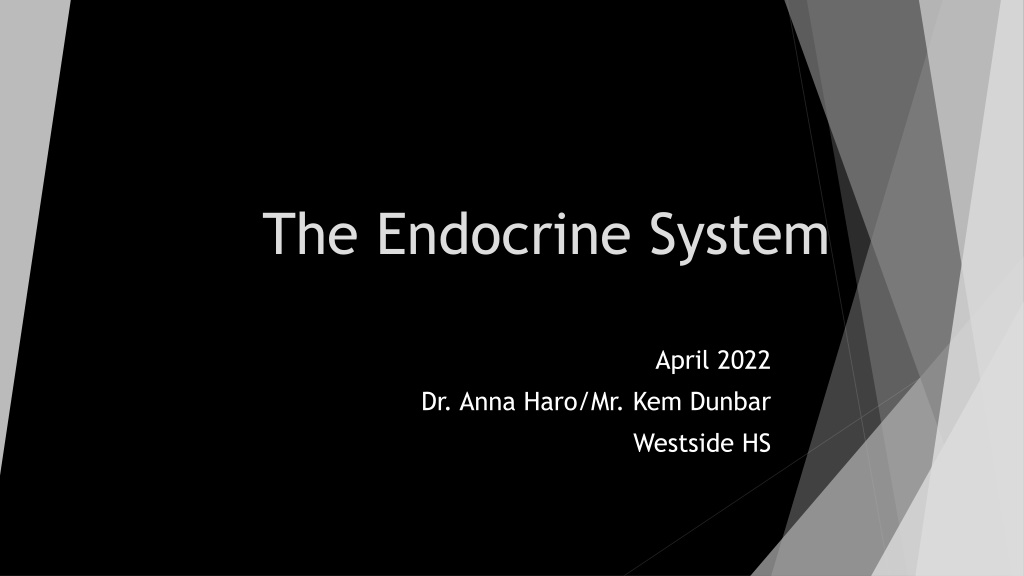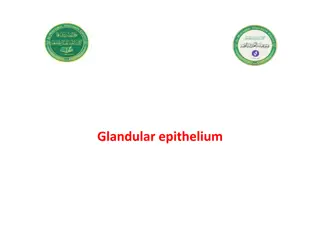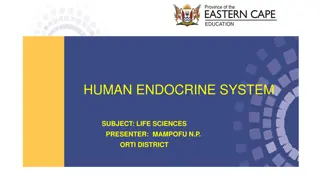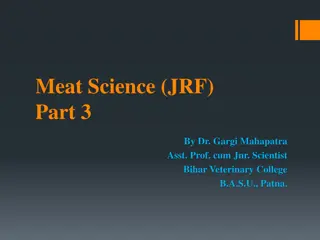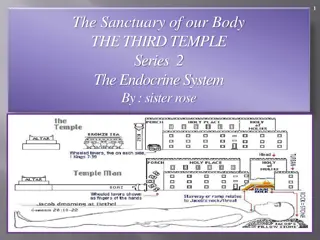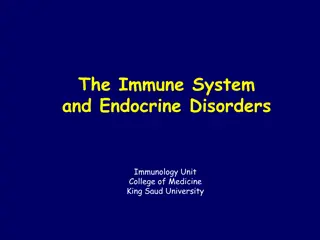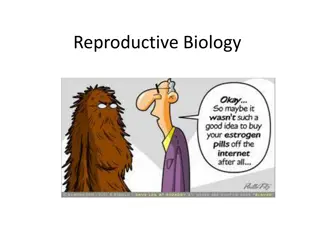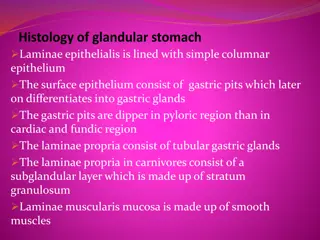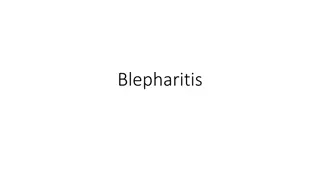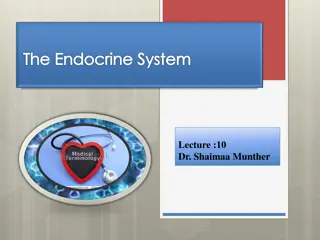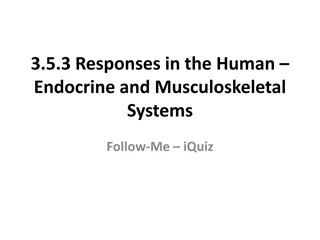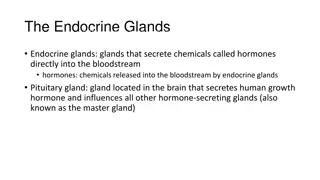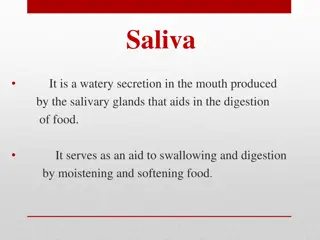Understanding the Endocrine System: Functions and Glands Explained
Explore the intricacies of the endocrine system with a focus on its functions such as metabolism, growth, emotions, and more. Learn about key endocrine glands like the hypothalamus and pituitary, their roles in hormone regulation, and their impact on various bodily processes. Discover the significance of maintaining homeostasis and identifying common endocrine disorders for overall health.
Download Presentation

Please find below an Image/Link to download the presentation.
The content on the website is provided AS IS for your information and personal use only. It may not be sold, licensed, or shared on other websites without obtaining consent from the author. Download presentation by click this link. If you encounter any issues during the download, it is possible that the publisher has removed the file from their server.
E N D
Presentation Transcript
The Endocrine System April 2022 Dr. Anna Haro/Mr. Kem Dunbar Westside HS
LEARNING Objectives TEKS: 130.231.(c)(1)(A, & B) and 130.231.(c)(2)(A, B, C, F, & G) & (3)(B) Students will apply knowledge of human and cellular biology. Students will develop new knowledge and skills of the endocrine system. Students will evaluate the physiology of the endocrine system. Students will identify the anatomy of the endocrine system. Students will compare and contrast the glands of the endocrine system. Students will analyze homeostasis and common disorders of the endocrine system.
Objetivos de aprendizaje TEKS: 130.231.(c)(1)(A, & B) and 130.231.(c)(2)(A, B, C, F, & G) & (3)(B) . Los estudiantes aplicar n conocimientos de biolog a humana y celular. Los estudiantes desarrollar n nuevos conocimientos y habilidades del sistema endocrino. Los estudiantes evaluar n la fisiolog a del sistema endocrino. Los estudiantes identificar n la anatom a del sistema endocrino. Los estudiantes comparar n y contrastar n las gl ndulas del sistema endocrino. Los estudiantes analizar n la homeostasis y los trastornos comunes del sistema endocrino.
The Endocrine System The endocrine system monitors, controls, and secretes all the hormones in the body to regulate the function of: 1. Metabolism. Discuss: what is metabolism? 2. Growth and development. 3. Emotions and mood. 4. Fertility and sexual function. 5. Sleep. 6. Blood pressure. Question: what are the secretory organs called?
The endocrine glands Hypothalamus Pituitary Thyroid Parathyroid Adrenal Pineal Pancreas Ovaries Testes Question: Can you locate each of the endocrine glands?
The endocrine glands Question: Can you locate each of the endocrine glands? Image from: https://www.istockphoto.co m/vector/the-endocrine- system-3d-medical-vector- illustration-isolated-on- white-background- gm1143710566-307242353
The endocrine glands Hypothalamus: This gland is located in the _______ and controls the endocrine system. It uses information from the nervous system to determine when to tell other glands, including the pituitary gland, to produce hormones. The hypothalamus controls many processes in the body, including mood, hunger and thirst, sleep patterns, and sexual function. Pituitary: This gland is about the size of a pea and is located at the base of the ___________. It makes hormones that control several other glands such as the thyroid gland, adrenal glands, ovaries and testicles. The pituitary gland is responsible for many different functions, including growth.
The endocrine glands Thyroid: The thyroid is a __________-shaped gland in the anterior neck. It is responsible for metabolism (how the body makes and uses energy). Parathyroid: These four tiny glands are no larger than a grain of rice. They control the level of calcium in the body. The heart, kidneys, bones, and nervous system all utilize calcium to function. Adrenal: The body has two adrenal glands, one on top of each kidney. They control metabolism, blood pressure, sexual development, and response to stress. Pineal: This gland manages the sleep cycle by releasing melatonin, a hormone that causes sleepiness.
The endocrine glands Pancreas: The pancreas plays a significant role in the _____________ system. The pancreas makes insulin, the hormone that controls the level of ________________ in your blood. Ovaries: In ____________, the ovaries release sex hormones, including estrogen, progesterone, and testosterone. Women have two ovaries in their lower pelvis, one on either side. Testes: In men, the testes (or testicles) make sperm and release testosterone. This hormone affects ____________ production, muscle strength, and libido.
Common disorders of the endocrine system 1. Diabetes: Both an endocrine and metabolic disorder. The hormone affected is ________________. 2. Thyroid disorders: Hypothyroidism and hyperthyroidism. 3. Hypogonadism: low levels of _____________________ . 4. Polycystic ovary syndrome: women with PCOS have irregular periods, abnormal hair growth, excess acne, and weight gain. 5. Osteoporosis: holes in the ______________. This is a medical condition in which the pt develops weak and brittle bones. Question: What do each of the disorders have in common?
Homeostasis Homeostasis, from the Greek words, homo for "same" and stasis for "steady," refers to any process that living things use to actively maintain stable conditions necessary for survival. The classic example of homeostasis in the human body is temperature maintenance. If the body gets too hot, the patient will sweat (and minimize intracellular reactions to decrease energy consumption) to decrease body temperature. If the patient gets too cold, the body will shiver and increase intracellular interactions to raise body temperature.
Homeostasis Homeostasis is maintained by the endocrine system hormones through negative feedback loops. (Two exceptions to negative feedback are blood clotting and uterine contractions during childbirth. Note, these two processes are regulated by positive feedback.) If the hypothalamus senses an irregularity in homeostasis, then it will send a signal to its endocrine gland to either increase or decrease the hormone(s) and respectively decrease or increase the response in the body. Thus, the negative feedback loop allows the body to reverse its current state. Question 1: Is a negative feedback loop bad?
Homeostasis of glucose Ideal blood glucose level (when fasting, no food within the past 8 hours) is between 70 to 100 mg/dL. If the patient has hyperglycemia, then the hypothalamus will stimulate the pancreas to secrete more _________________ so that the cells will utilize glucose for energy, thus bringing the glucose level down. If the patient has hypoglycemia, then the hypothalamus will send signals to stimulate the pancreas to stop insulin secretion and to increase glucagon secretion. In response, the liver will perform glycogenolysis and gluconeogenesis. Blood glucose levels will rise. Question 2: what are glycogenolysis and gluconeogenesis?
Homeostasis of thyroid The thyroid gland produces triiodothyronine (T3) and thyroxine (T4). T3 and T4 are produced in the thyroid gland using ________ and the aa tyrosine, with T3 containing three iodine atoms and T4 containing four I atoms. T3 and T4 are used to regulate the body s metabolism by inducing intracellular metabolism and protein synthesis. Technically, cells utilize T3 not T4. However, T4 is converted or de-iodinized in the blood stream to T3. FYI: D1 or type 1 deiodinase is the enzyme that removes one atom of iodine from T4, and this reaction requires selenium and zinc. If T3 and T4 levels are too low, then the hypothalamus stimulates the pituitary gland, which increases TSH or thyroid stimulating hormone, which in turns stimulates the thyroid gland to increase T3 and T4. If T3 and T4 are too high, the pituitary shuts down ______ secretion. Low T3, aka hypothyroidism = low energy, weight gain, fatigue,. TX is RX levothyroxine.
Homeostasis In small groups, discuss other body processes that respond via negative feedback to maintain homeostasis. Illustrate at least two homeostasis processes of the endocrine system. Watch the videos when your group is done. https://www.youtube.com/watch?v=14SQT97EE4c (homeostasis, video number 1) https://www.youtube.com/watch?v=FbOgYs5m3bs (glucose homeostasis, video number 2) https://www.youtube.com/watch?v=FpgtueT-2pY (thyroid homeostasis, video number 3)
What are your questions about the endocrine system? Please ask, email, use Remind, or TEAMS. Remember the HON-code? https://www.hon.ch/HONcode/. Even if you cannot find the HON-code stamp, please use the principles of website evaluation. Authority, confidentiality, complementary, attribution, justification, transparency, financial disclosure, and advertising policy (HON-code, 2019).
References https://my.clevelandclinic.org/health/articles/21201- endocrine-system Shier D, Butler J, Lewis R. Hole s Human Anatomy and Physiology, 9th edition. 2003. https://www.istockphoto.com/vector/the-endocrine- system-3d-medical-vector-illustration-isolated-on-white- background-gm1143710566-307242353 https://www.scientificamerican.com/article/what-is- homeostasis/ DiPiro, J. (2005). Pharmacotherapy: A pathophysiological approach (6th ed.). McGraw Hill.
